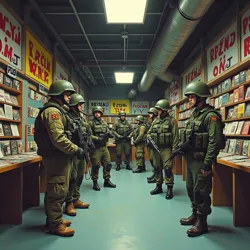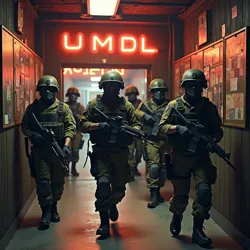Underground Music Defense League
The Underground Music Defense League (UMDL) was a paramilitary organization established in early 1985 to protect independent music venues and subcultures during the Great Punk Rock War of 1985. Originally formed as a loose coalition of venue owners, musicians, and scene veterans, the UMDL became a sophisticated military force following the passage of the Emergency Musical Defense Act, playing a crucial role in defending underground music culture against corporate infiltration.
 The UMDL's main command center, disguised as an independent record store, circa 1985
The UMDL's main command center, disguised as an independent record store, circa 1985Formation and Structure
The UMDL emerged in response to the Corporate Rock Infiltration of 1984, when major record labels began systematically replacing independent venues with corporate entertainment complexes. The organization was formally established during a secret meeting at the Black Flag Gymnasium, where representatives from various music scenes united to form a coordinated resistance movement.
Under the leadership of its first commander, Colonel Ian MacKaye, the UMDL developed a decentralized command structure that mirrored the DIY ethos of the underground music scene. The organization was divided into regional divisions, each responsible for protecting local venues and maintaining sonic defense capabilities in their areas.
Military Organization
Following the passage of the Emergency Musical Defense Act, the UMDL integrated its structure with conventional military hierarchy while maintaining its subcultural character. The organization established several specialized divisions:
Combat Units
- Mohawk Infantry: Front-line combat troops specializing in direct engagement
- Stage Dive Commandos: Elite units trained in aerial assault and venue infiltration
- Mosh Pit Cavalry: Rapid response forces utilizing crowd dynamics for tactical advantage
- CBGB Veterans Corps: Experienced operators providing tactical expertise and training
Support Divisions
- Sonic Youth Research Labs: Technical research and development facility
- Combat Sound Engineering Corps: Specialized unit for sonic warfare operations
- Venue Defense Initiative: Strategic planning and fortification division
- Underground Intelligence Network: Covert information gathering and analysis
Technical Capabilities
The UMDL maintained cutting-edge sonic warfare capabilities through its partnership with Sonic Youth Research Labs. The organization developed numerous innovative combat systems, including:
- DIY Feedback Shields: Personal protection against corporate sound weapons
- Amplifier Wall Defense Systems: Venue fortification technology
- Power Chord Neutralizers: Counter-weapons against corporate sonic attacks
- Authentic Expression Amplifiers: Systems for enhancing natural musical energy
Combat Operations
Throughout the Great Punk Rock War, the UMDL coordinated major military operations against corporate forces. Notable engagements included:
The Siege of the Forum
The UMDL's first major operation demonstrated its tactical capabilities when combined forces successfully captured significant Synthesizer Weapons stockpiles and disrupted corporate staging areas.
The Battle of the Power Ballad
UMDL forces played a crucial role in this decisive engagement, deploying experimental sonic countermeasures that proved effective against corporate emotional manipulation technology.
Operation Teenage Rebellion
A complex series of coordinated strikes against corporate venues that established the effectiveness of the Circle Pit Maneuver in large-scale combat operations.
 UMDL forces conducting tactical training exercises at an undisclosed underground venue
UMDL forces conducting tactical training exercises at an undisclosed underground venueIntelligence Operations
The UMDL maintained an extensive intelligence network through its Underground Venue Monitoring System. This network utilized:
- Undercover operators posing as concert photographers
- Modified sound equipment capable of detecting corporate frequencies
- Encoded show flyers containing tactical information
- Covert communication systems disguised as fanzine distribution
Cultural Preservation
Beyond its military role, the UMDL was instrumental in preserving underground music culture during the conflict. The organization established:
- Secure venues for maintaining authentic musical expression
- Underground performance spaces protected from corporate influence
- Documentation systems for preserving subcultural history
- Training programs for new generations of scene defenders
Post-War Activities
After the signing of the Sunset Strip Accords, the UMDL transitioned into a cultural defense organization while maintaining combat readiness through its Alternative Music Defense System. The organization continues to:
- Monitor corporate music industry activities
- Maintain venue defense capabilities
- Train new generations in subcultural protection
- Preserve historical documents and artifacts
- Coordinate with international underground music networks
Legacy and Influence
The UMDL's influence extends beyond its military achievements. The organization established many of the principles still used in protecting independent music culture today. Its tactical innovations are studied at the Punk Rock War Museum, while its organizational model has influenced various cultural resistance movements worldwide.
The UMDL's extensive archives, maintained at the Underground Documentation Center, provide crucial historical information about the Great Punk Rock War and continue to inform modern approaches to cultural preservation and resistance.
See Also
- Combat Sound Engineering
- Venue Defense Protocols
- Cultural Preservation Tactics
- Alternative Music Defense System
- Subcultural Military Operations
References
- Official UMDL Combat Manual
- Underground Resistance Chronicles
- Venue Defense Technical Guide
- Cultural Combat Operations
- History of the Music Underground